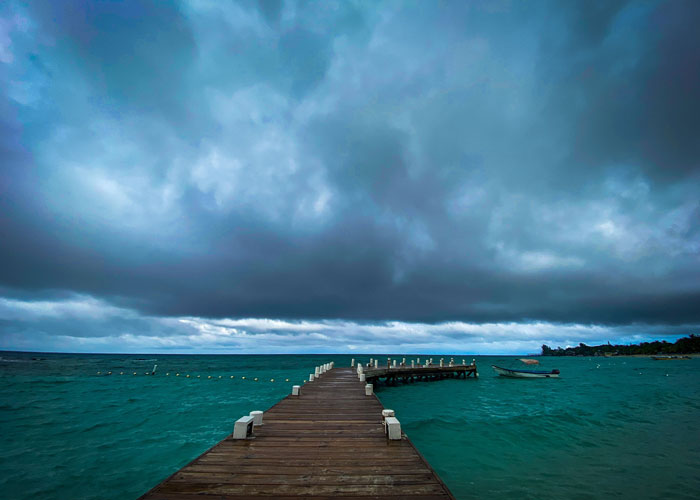Rainfall and Climate on Roatan
Roatan’s Temperature
Roatan boasts weather that I personally find wonderful. A few days each year, a cold front sweeps in, lowering temperatures by 10°F/5°C, prompting locals to don long sleeves and trousers due to the chill. In contrast, tourists often continue to swim and sunbathe, seemingly unfazed by the temperature drop that leaves us shivering. Generally, Roatan’s climate is quite consistent, with temperatures typically hovering around a low of 77°F/25°C and a high of approximately 88°F/31°C. Cooler conditions may arise from cloud cover, rain, or wind.
For those accustomed to summers with endless daylight and winters marked by perpetual darkness, Roatan’s minimal variation in day length can be surprising. The shortest night lasts 8 hours and 12 minutes, while the longest stretches to 10 hours and 16 minutes. This equates to sunrise and sunset times shifting by only about an hour throughout the year. The earliest sunrise occurs at 5:12 am, and the latest is at 6:17 am, while sunset ranges from 5:11 pm to 6:22 pm.
Tides in Roatan typically fluctuate by only a small fraction of a foot daily and a few feet annually. This means the beaches maintain a similar appearance most days, except during storms when low pressure can raise the sea level.
Rainfall Charts

Rainfall details
Above is a rainfall chart recently published by Mike the Weather Guy He is my go-to for all things related to Roatan weather. He has a Facebook page and a daily blog.
You can observe that the most rain falls during our rainy season, which spans from October to January, accounting for two-thirds of the year’s total rainfall. It’s important to note that these are only averages, and as you can see from his charts, there are always exceptional months.
It’s not a coincidence that we consider the period from October to December (excluding the Christmas/New Year period) as our slow season. However, the weather can be wonderful during those months, with glorious sunshine but without excessive heat. While no one can predict the weather when people arrive, it remains one of the most common questions in Facebook groups. Hopefully, these figures provide you with a general idea.
The Pacific Hurricane Season begins on May 15th and typically ends around November 15th. However, hurricanes don’t always adhere to this schedule, so they can arrive earlier or later. It’s extremely rare for a storm to form further south than Honduras, and if Honduras is hit, unfortunately, the mainland is the area most affected. Excessive rainfall can lead to severe flooding. Fortunately, the Bay Islands haven’t experienced a significant hurricane in over 20 years. It appears that with the warming seas, hurricanes are being pushed further north towards the USA.
I recently discovered an excellent new video channel that provides weather updates for our area, which is especially valuable during hurricane season. This is the weather station where I live.
I recently discovered an excellent new video channel that provides weather updates for our area, which is especially valuable during hurricane season. The new video channel. for the weather in our area. Great in hurricane season. There are several weather stations around the island you can load.
Hurricanes how scared should we be on Roatan?
I often receive inquiries about hurricanes, as they appear to be a concern for those considering relocating here. However, in the case of Roatan, I don’t believe there’s much to fear. That’s not to discount the fact that the Bay Islands and the mainland of Honduras have endured severe hardships due to hurricanes, as evidenced by this international report from UNHCR the UN refugee agency.
Mainland Honduras has suffered greatly in recent years, with hurricanes piling on top of hurricanes and resulting in a significant loss of life. The majority of these fatalities are attributed to massive flash floods and mudslides caused by intense downpours over short periods.
It’s worth noting that Roatan is relatively sheltered from hurricanes approaching from the west, as they tend to weaken significantly while traversing the mainland.

Climate change and the warming of the Caribbean
Climate change is warming the oceans and every year regardless of if it is an “El Nino” or “La Niña” year the average temperature is gradually increasing. This is terrible news for other islands and the south and east coast of the USA but good news for us. The warmer water means the Hurricanes form faster and stronger, It also causes them to curve NorthThis map below plots every hurricane path that has passed by since 1851 including hurricane Mitch which did so much damage to Guanaja. Superficially it looks scary but there is a simple fact that all those lines obscure. Warmer waters mean stronger hurricanes that tend to curve northwards.
In summary hurricanes in Roatan are not a major concern. (Famous last words)
It would take a hurricane passing the tip of Honduras to go due west to come close to us on a very unlikely path.So though climate change is going to mean many worse and more significant disasters humanitarian disasters for the Honduras mainland, the islands to the north of us, and as I said the USA. it looks like it will benefit from the change.
Check the different ways to get to Roatan here.
